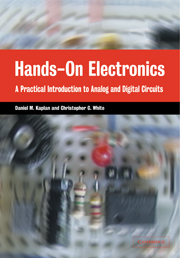Book contents
- Frontmatter
- Contents
- List of figures
- List of tables
- About the authors
- To the Reader
- Acknowledgments
- Introduction
- 1 Equipment familiarization: multimeter, breadboard, and oscilloscope
- 2 RC circuits
- 3 Diodes
- 4 Bipolar transistors
- 5 Transistors II: FETs
- 6 Transistors III: differential amplifier
- 7 Introduction to operational amplifiers
- 8 More op amp applications
- 9 Comparators and oscillators
- 10 Combinational logic
- 11 Flip-flops: saving a logic state
- 12 Monostables, counters, multiplexers, and RAM
- 13 Digital↔analog conversion
- Further reading
- Appendix A Equipment and supplies
- Appendix B Common abbreviations and circuit symbols
- Appendix C RC circuits: frequency-domain analysis
- Appendix D Pinouts
- Glossary of basic electrical and electronic terms
- Index
4 - Bipolar transistors
Published online by Cambridge University Press: 06 July 2010
- Frontmatter
- Contents
- List of figures
- List of tables
- About the authors
- To the Reader
- Acknowledgments
- Introduction
- 1 Equipment familiarization: multimeter, breadboard, and oscilloscope
- 2 RC circuits
- 3 Diodes
- 4 Bipolar transistors
- 5 Transistors II: FETs
- 6 Transistors III: differential amplifier
- 7 Introduction to operational amplifiers
- 8 More op amp applications
- 9 Comparators and oscillators
- 10 Combinational logic
- 11 Flip-flops: saving a logic state
- 12 Monostables, counters, multiplexers, and RAM
- 13 Digital↔analog conversion
- Further reading
- Appendix A Equipment and supplies
- Appendix B Common abbreviations and circuit symbols
- Appendix C RC circuits: frequency-domain analysis
- Appendix D Pinouts
- Glossary of basic electrical and electronic terms
- Index
Summary
Invented in 1947, transistors (and integrated circuits made from them) have been the basis for the explosive proliferation of electronic devices that revolutionized so much of life in the latter half of the twentieth century. Although discrete (i.e. individually packaged) transistors are now used mainly in special situations (e.g. where high power or speed is required), since transistors form the basis of a large class of integrated circuits, an understanding of how they work remains valuable. This will be the subject of the next few chapters. This chapter will introduce you to some basic bipolar-junction-transistor circuits.
Apparatus required
Breadboard, oscilloscope, two multimeters, 2N3904 and 2N3906 transistors, red light-emitting diode (LED), 1N914 (or similar) silicon signal diode, two 330 Ω, two 10 k, and one each of 100 Ω, 1 k, 3.3 k, 22 k, and 100 k 14 W resistors, 1 μF capacitor.
Bipolar-junction-transistor basics
Why and how transistors work is a bit subtle and can easily confuse the beginning student, but it is something you must master. Study the following description carefully, and compare it with the descriptions in other books. You may also want to re-read both our description and others after you've had some experience building and analyzing transistor circuits. (If you want more of the background detail on semiconductor physics, good places to look are Simpson's Introductory Electronics for Scientists and Engineers, or any textbook on modern physics.)
- Type
- Chapter
- Information
- Hands-On ElectronicsA Practical Introduction to Analog and Digital Circuits, pp. 47 - 64Publisher: Cambridge University PressPrint publication year: 2003



